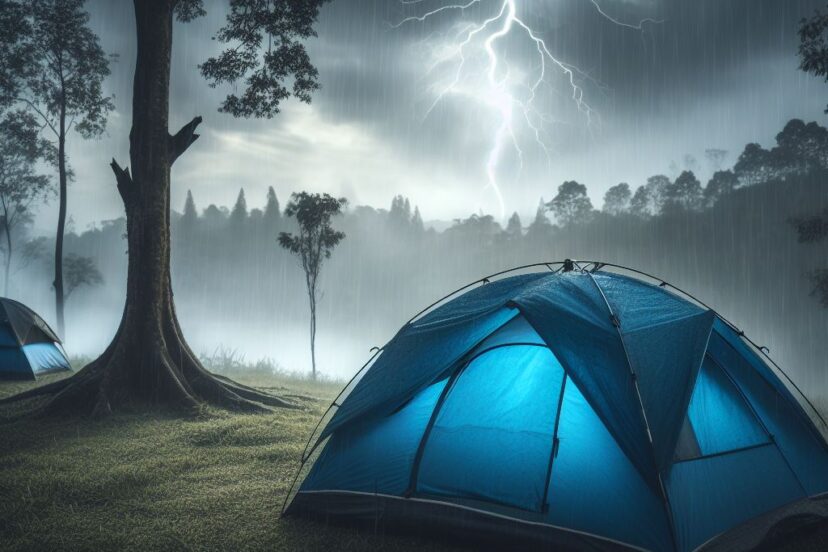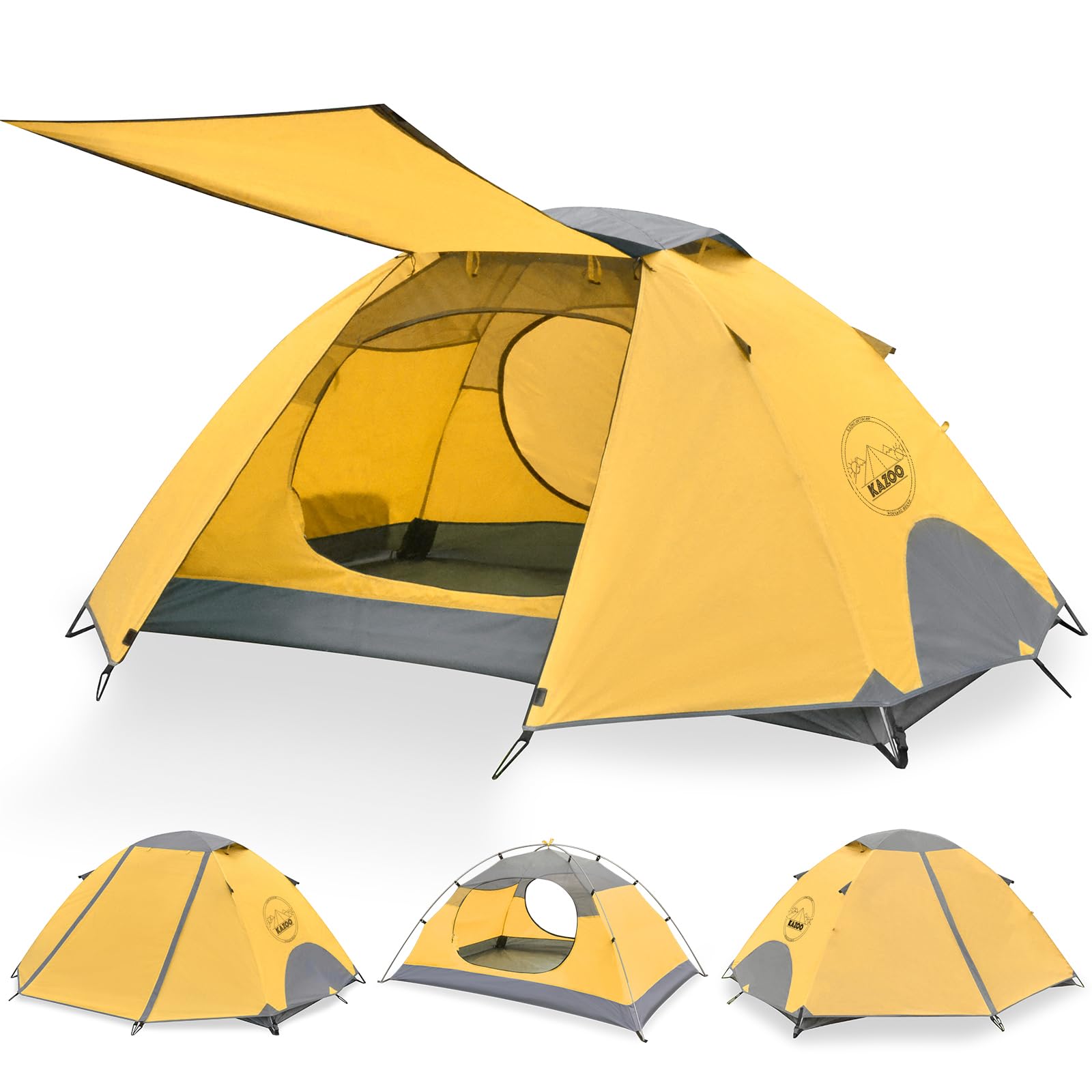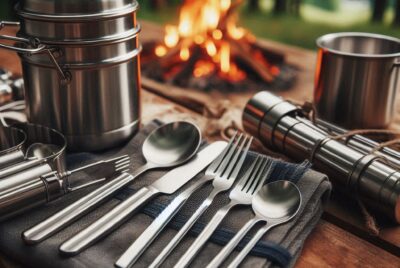Waterproof Camping Tent: Your Ultimate Outdoor Shelter
*We may earn a commission for purchases made using our links. Please see our disclosure to learn more.
Waterproof Camping Tent Essentials: Durability and Comfort for the Outdoors
Camping conjures up images of adventure, exploration, and communing with nature. Key to this outdoor pursuit is the quintessential piece of equipment: the tent. Among tents, a waterproof camping tent stands out as an essential for those looking to ensure their outdoor experience remains comfortable regardless of weather conditions. These tents are designed with specialized materials and coatings to repel water, and they come in various shapes and sizes to accommodate the diverse needs of campers.
A waterproof camping tent is more than just a shelter; it is a bulwark against the elements. The material typically used for waterproof tents is nylon or polyester with a waterproof coating, such as polyurethane or silicone. Quality seams are critical—they must be tightly sealed to prevent water ingress. Moreover, the tent’s design often includes a rainfly—a separate waterproof cover that fits over the roof of the tent for additional rain protection.
When considering a purchase, I pay close attention to the tent’s hydrostatic head rating, which measures how much water pressure the fabric can withstand before leaking. A higher number indicates better waterproofing. The tent’s weight and ease of assembly are also important, especially for backpackers or solo campers. Ventilation is crucial as well, to prevent condensation build-up inside the tent.
My focus has been on identifying a selection of the best waterproof camping tents by examining their materials, construction quality, and practical features such as ease of use and ventilation. The results of this in-depth analysis come from hours of research and personal testing, aimed at finding tents that are not only dry but also comfortable and convenient for a variety of camping experiences.
Top Waterproof Camping Tent Selections
I’ve meticulously researched and tested numerous tents to find the most reliable options for staying dry during outdoor adventures. The following list showcases the best waterproof camping tents, chosen for their robust weatherproofing, durability, and overall value. Whether you’re a solo backpacker or a family on a weekend trip, you’ll find a suitable shelter that stands up to the elements and enhances your experience in the great outdoors.
Amazon Basics 4-Person Dome Tent
I found this tent strikes a fine balance between cost-effectiveness and functionality for casual camping enthusiasts.
Pros
- Exceptionally easy setup, achieved in mere minutes.
- Surprisingly spacious interior, comfortably fitting my group of four.
- Adequate ventilation with a cool-air port and a back window.
Cons
- Susceptible to condensation, which may require extra ventilation steps.
- The rainfly, while effective, doesn’t offer complete waterproofing in heavy rain.
- The poles feel a bit flimsy; consider upgrading them for longevity.
The Amazon Basics 4-Person Dome Tent made my weekend trip a breeze with its quick setup. I appreciated the color-coded poles and snag-free sleeves that allowed me to have the tent ready for occupancy rapidly, which is a blessing after a long day of hiking.
Inside, the tent felt cozy and not at all cramped as some 4-person tents can be. I actually managed to fit an air mattress inside, leaving sufficient room for gear and movement. The interior mesh pocket was a nice touch for stowing small items securely.
However, I did notice condensation after a night of cool temperatures, which suggests that while it can shield you from light rain, this tent might struggle in a downpour. My advice is to keep the back window and cool-air port open when weather permits, which significantly improves airflow and reduces moisture buildup. Despite this, for its price point, the Amazon Basics Dome Tent is a prime choice for those occasional camping trips with friends or family.
Coleman Sundome Tent
I recommend the Coleman Sundome Tent for campers seeking a reliable and easy-to-assemble shelter that stands up to the elements.
Pros
- Waterproof design with welded corners and inverted seams
- Stable in high winds, tested at over 35mph
- Enhanced airflow due to large windows and ground vent
Cons
- Fiberglass poles may require careful handling to ensure longevity
- Limited center height for taller individuals
- Single door entry can be less convenient for multiple occupants
After a weekend of camping in unpredictable weather, the Coleman Sundome Tent proved to be a sturdy companion. Its weatherproofing was truly tested, and I stayed dry thanks to the well-designed rainfly and tent’s welded corners, which Coleman confidently includes. Getting the tent ready was a breeze; in fact, I clocked just under 10 minutes from start to finish without rushing.
The tent’s stability was impressive during a night when the wind picked up unexpectedly. I admit I was a bit concerned initially, wondering if the structure would hold, but the Sundome withstood over 35mph winds without a quiver. The ventilation was another win; large windows and a ground vent worked together to keep the air inside fresh and condensation at bay—a much-appreciated feature after a long day of hiking.
However, it wasn’t without its drawbacks. I noticed the fiberglass poles, while lightweight, could become a weak point over time, so handling them with care is paramount. Also, at just under 5 feet, the center height made it a slight hunch over for me, and I’m about average height. That coupled with a single door meant some coordination was needed when my camping buddy and I were moving in and out.
In sum, the Coleman Sundome Tent strikes an excellent balance between functionality and ease of use for campers who prioritize quick setup and robust weather protection.
Coleman Evanston 6-person
If you’re seeking a spacious family tent with reliable weatherproofing, the Coleman Evanston is a solid choice.
Pros
- Effective water resistance with a handy rainfly
- Ample interior space fits two queen air beds comfortably
- Screened porch adds an enjoyable bug-free lounging area
Cons
- Bulkiness may not suit backpacking trips
- Screen room lacks a floor, which might let water in
- Pole durability could be stronger, as per some reports
After spending a weekend with the Coleman Evanston Tent, I found that the clever construction keeps you dry during rain showers, thanks to the seam welding and the protective rainfly. Pitching the tent could hardly be simpler, and I appreciate that it stands firm once set up, creating a cosy shelter against elements.
The space inside surprised me; it fits two queen-sized air beds with room to spare, a rare find in tents that claim to accommodate six people. Standing up inside is a breeze due to its generous center height, and moving around never felt cramped.
For me, the standout feature remains the screened porch. It’s such a pleasure to sit there, enjoying nature without swatting flies away. Although, I did notice that during a downpour, water could sneak in as the screen room lacks a base.
I did find the tent heavy, so it’s not the best option if you plan to carry your shelter a long distance. And while the overall structure seems robust, after a couple of uses, I heard reports from fellow campers of the elastic cords in the poles giving way.
Lastly, it’s worth mentioning you’d want to ensure you have a car close by to transport this tent to the campsite due to its heft, making it less suitable for those trekking to their camping spots.
Coleman Instant Cabin
I recommend the Coleman Instant Cabin for its remarkable ease of setup and robust waterproofing, perfect for family camping trips.
Pros
- Almost effortless to pitch and pack down
- Capably withstands adverse weather
- Ample interior space for comfortable sleeping
Cons
- Might be too bulky for backpacking
- Can get stuffy if not properly ventilated
- Limited headroom for taller users
After spending a weekend in the great outdoors with the Coleman Instant Cabin, I’m convinced it’s a superb choice for families and groups. Its claim of a 60-second setup isn’t just a gimmick; I had it standing in no time with the pre-attached poles that clicked into place intuitively. The WeatherTec system’s welded floors and inverted seams did an excellent job repelling a sudden downpour, keeping my gear and myself completely dry.
I appreciated the thoughtful details like the integrated storage pockets which helped me keep my essentials organized and easily accessible. However, it’s noteworthy that while the tent is spaciously designed for four, the height can be a pinch for anyone over six feet tall. It also won’t win any points for portability on long treks given its 18-pound weight, but for car camping, it’s hardly a dealbreaker.
Another aspect I liked was the tent fabric’s durability. It felt rugged and capable of enduring many seasons of use, and the ease with which the tent packed back into its expandable bag was a plus. The ventilation system, combined with the rainfly, kept the interior climate comfortable, although on calmer nights, I did notice it required a bit more effort to maintain airflow.
Overall, the Coleman Instant Cabin lives up to the expectations of a quick-setup, secure shelter in the wilderness, striking a good balance between comfort and performance.
KAZOO Cometary 2P Tent
I recently had the pleasure of using the KAZOO Cometary 2-person tent and its balance of lightweight design and robust weatherproofing impressed me.
Pros
- Withstood torrential rains without a single leak due to its high waterproof rating.
- Assembly was straightforward even when I set it up solo.
- The tent was surprisingly roomy, offering plenty of space for two adults and storage.
Cons
- The included stakes felt a bit flimsy; I might replace them with sturdier ones for rocky terrain.
- Despite good overall ventilation, the tent could get warm during peak sunlight hours.
- At 5.4 pounds, it’s very manageable, but if you’re an ultra-light backpacker, every ounce counts.
Trekking through the backcountry, the last thing you want is a complicated tent setup. The KAZOO Cometary was refreshingly simple to erect. Even with just my own two hands, the aluminum poles snapped into place without fuss, giving me a stable shelter in no time.
Ventilation is crucial in a tent, especially in humid conditions. This design’s ceiling vents were a godsend, ensuring that condensation didn’t dampen my spirits or gear. The tent’s interior, complete with mesh pockets, kept my essentials organized and easy to reach in the dark.
Durability can make or break a camping trip. Throughout my journey, the KAZOO Cometary faced down gusty winds and heavy downpour. Thanks to its sturdy build and ripstop polyester, I stayed dry and secure inside. This tent proved to be a reliable companion on the trail, fulfilling its promise of a dry and worry-free camping experience.
Waterproof Camping Tent – Buying Guide
Understanding Waterproof Ratings
When I choose a tent, I pay close attention to the waterproof rating, measured in millimeters (mm). This indicates how much water pressure the tent fabric can withstand before leaking.
| Waterproof Rating (mm) | Protection Level |
| 0 – 600 | Water-resistant |
| 600 – 1200 | Waterproof in light rain |
| 1200 – 2000 | Waterproof in moderate rain |
| 2000+ | Waterproof in heavy rain |
Tent Material
The fabric of the tent is critical. I look for materials like polyester and nylon for their durability and water resistance. Canvas tents are excellent for water repellency but are heavier.
- Polyester & Nylon: Lightweight, durable, repels water well.
- Canvas: Naturally waterproof, very sturdy, but heavier.
Tent Construction
I ensure that seams are double-stitched and fully taped or welded to prevent water ingress. The tent’s design should avoid flat surfaces where water can pool.
- Seams: Must be double-stitched and fully sealed.
- Design: Angled or dome-shaped to prevent water pooling.
Ventilation
Proper ventilation is important to avoid condensation inside the tent. I check for the presence of multiple vents and the ability to open and close them to regulate airflow.
- Vents: Multiple, adjustable for airflow management.
- Mesh Panels: Allow for breathability while keeping bugs out.
Additional Features
I consider features that enhance the camping experience. An extended rainfly provides additional shelter, while interior pockets help me organize my gear.
- Rainfly: Should extend beyond the tent body.
- Pockets & Loops: For organizing gear inside the tent.
FAQs About Your Waterproof Camping Tent
In my experience, understanding a tent’s water resistance and maintenance needs is essential for outdoor adventures. Here, I address common inquiries with straightforward, expert advice.
1. How do you test a tent for water resistance?
I typically assess a tent’s water resistance using the industry-standard water column test. This involves measuring the height of a water column that the fabric can withstand before leaking. Additionally, applying water to the tent and observing for leaks is a practical field test.
2. What features are important for a heavy-duty waterproof tent?
For a reliable heavy-duty waterproof tent, I look for features such as high-denier fabric, reinforced seams, and a durable waterproof coating. A tub floor design to prevent seepage and quality zippers further enhance water resistance.
3. Can you recommend a durable waterproof tent suited for four-season camping?
For four-season camping, I find the Mountain Hardwear Trango or Hilleberg Tarra to be exceptional options. These tents are constructed for year-round durability, with robust materials and designs that withstand extreme weather conditions.
4. What maintenance is required to keep a camping tent waterproof over time?
Maintaining a camping tent’s waterproofing involves regular cleaning and reapplying a waterproof treatment when necessary. I pay special attention to the tent’s seams and areas that show wear, using a seam sealer to prevent potential leaks.
5. Are there waterproof tents that also offer good breathability?
Yes, there are waterproof tents with excellent breathability. Look for tents with a breathable inner canopy, ample venting options, and materials like Gore-Tex which provide a good balance between waterproofing and breathability.









